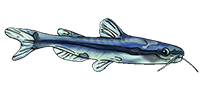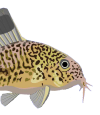Roxo, F. F., Souza, C., Silva, G. J. D. C., Foresti, F., & Oliveira, C. (2018). Genetic and morphological analyses demonstrate that
Schizolecis guntheri (Siluriformes: Loricariidae) is likely to be a species complex.
Frontiers in Genetics,
9, 69. doi: 10.3389/fgene.2018.00069
is a monotypic genus of Siluriformes widely distributed throughout isolated coastal drainages of southeastern Brazil. Previous studies have shown that fishes groups found in isolated river basins tend to differentiate over time due to the absence of gene flow resulting in allopatric speciation. In this study, we used partial sequences of the mitochondrial gene COI with the analysis of the General Mixed Yule Coalescent model (GMYC) and the Automatic Barcode Gap Discovery (ABGD) for single locus species delimitation, and a Principal Component Analysis (PCA) of external morphology to test the hypothesis that
is a complex of species. We analyzed 94 samples of
S. guntheri for GMYC and ABGD, and 82 samples for PCA from 22 coastal rivers draining to Atlantic in southeastern of Brazil from the Paraná State to the north of Rio de Janeiro State. As a result, the GMYC model and the ABGD delimited five operational taxonomy units (OTUs – a nomenclature referred in the present study to the possible new species delimited for the genetic analysis), a much higher number compared to the traditional alfa taxonomy that recognize only
S. guntheri across the isolated coastal rivers of Brazil. Furthermore, the PCA analysis suggests that
S. guntheri is highly variable in aspects of external body proportions, including dorsal-fin spine length, pectoral-fin spine length, pelvic-fin spine length, lower caudal-fin spine length, caudal peduncle depth, anal width and mandibular ramus length. However, no exclusive character was found among the isolated populations that could be used to described new species of
Schizolecis. Therefore, we can conclude, based on our results of PCA contrasting with the results of GMYC and ABGD that
S. guntheri represents a complex of species.
- Keywords: Coastal drainages, catFISH, molecular identification, COI gene, GMYC model






